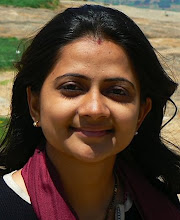 Dhanusha means a bow. The hands are used like a bowstring to pull the head, trunk and legs up and the posture resembles a bent bow. Therefore this asana is called "Dhanurasana". It is a combination of Bhujangasana and Shalabhasana. This asana bends the spine backwards. This trio works contrary to Halasana and Paschimotanasana which bend the spine forward. Dhanurasana is also called Urdhva Chakrasana.
Dhanusha means a bow. The hands are used like a bowstring to pull the head, trunk and legs up and the posture resembles a bent bow. Therefore this asana is called "Dhanurasana". It is a combination of Bhujangasana and Shalabhasana. This asana bends the spine backwards. This trio works contrary to Halasana and Paschimotanasana which bend the spine forward. Dhanurasana is also called Urdhva Chakrasana.Technique :
- Lie prone on the floor on the stomach, face downwards. Relax the muscles. Keep the arms resting alongside th ebody.
- Bend the legs at the knees.
- Raise the arms and hold the ankles with the hands. Raise the chest and the head. Fill the lungs with air.
- straighten and stiffen the hands. Stiffen the legs also.The body now assumes the posture of a convex arch.
- If you lift the legs up,you can raise the chest . Hold the breath.
- Then exhale slowly.Attempt to keep the knees together.
- Stay in this position as long as possible. It can be practiced 5-6 times.
- In this asana, the abdomen supports the whole body. So practice this asana when the stomach is empty.
- The body in Dhanurasana pose gets good exercise if it is lightly rocked from left to right and forward and backward.
- Do not try to bring the toes near ears forcefully if it is difficult.
- Gradually increase the practice.
- One who regularly practices Halasana, Mayurasana and Dhanurasana never becomes lazy. One is always active and energetic.
- This asana gives a good massage to the abdomen so it cures prolonged constipation, dyspepsia,and other disorders of the stomach.
- Increases energy and counteracts depression.
- It cures spinal hump and rheumatism of the legs, the knees and the hands.
- It reduces fat. It activates the intestines and increases the digestive power.
- It nourishes all the abdominal organs by supplying blood to them. This asana is a blessing to those who suffer from gas and other intestinal disorders.
- stretches the chest and lungs.
- This asana is very beneficial specially to women because it alleviates the menstrual disorders and improves the reproductive system.
- This asana rejuvenates the spine . It prevents bones from being untimely degenerated.
- It activates the pancreas and insulin is produced in proper proportion.
High and low blood pressure, Migraine, Insomnia, Serious lower back, Neck injury, Diarrhoea, Headache, Heart problem, Peptic ulcer, Hernia, Thyroid or endocrine gland disorders.





